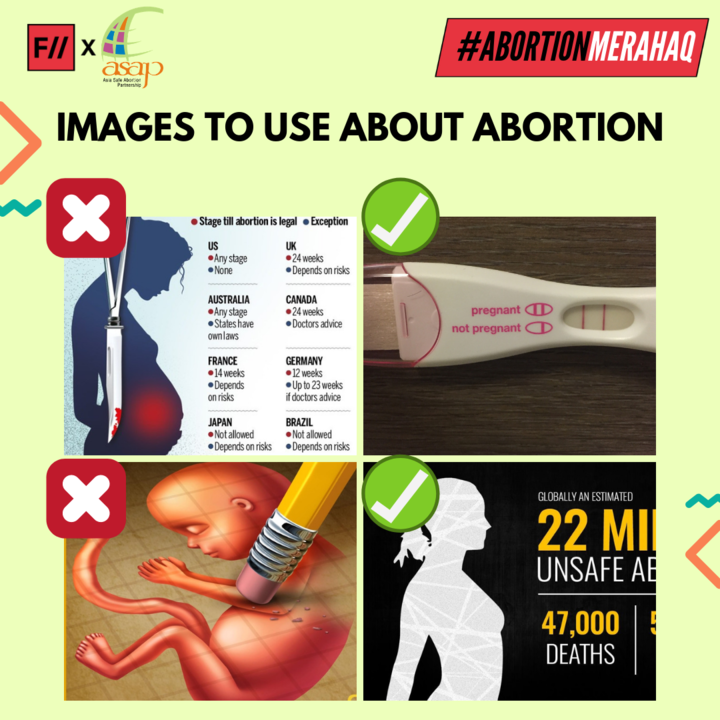Be non-judgemental! Believing that individuals have the right to make decisions about their own bodies means that no one abortion is more ‘justified’ than another. However, as individuals ourselves, we hold our own have personal values, beliefs and experiences, but it is important that messages about abortion are factual and supportive of individual choices.
ON CREDIBILITY
- Given the amount of misinformation and commonly circulated myths, it is important that we provide accurate and updated statistics wherever possible to support our position.
- However, be careful to only include statistics and data that are relevant to the main message of the material. For instance, it is unlikely to be relevant to include statistics about sex selective abortion in a piece explaining the clinical options available for abortion in India.
- Always provide references and resources: As well as giving citations for factual information, all content about abortion should enable audiences to obtain further information about abortion and related services. When individuals have access to resources, they are less likely to resort to unsafe practices.
- Be sure to cross-check the credibility of the sites from which you source your information. A number of anti-choice websites often pose as independent and objective spaces, but provide inaccurate and misleading information.
- You can check information from one source against data from another to make sure that your data is reliable.
- If you are using any images, or sharing personal histories and case studies, ensure that you have the consent of those involved to use and share this material. Images already in circulation should be reshared only after you ensure that they are marked for re-circulation.
LANGUAGE MATTERS
- Keep in mind that your audience may not be familiar with the subject. So your language must be accessible and clear.
- Make sure you spell out all acronyms the first time they are used. While you may use these acronyms frequently, your audience may not be familiar with them.
- It is important that you use accurate language in your material to ensure that it contains correct information. It can be easy to unintentionally stigmatise abortion by the language used, and therefore it’s even more important to use the right phrases and terms. A list of commonly used phrases, and their preferred alternatives are listed below.

How to write about abortion
| NOT RECOMMENDED | PREFERRED TERM | EXPLANATION |
| Baby Dead Foetus Unborn baby Unborn child | Embryo (up to week 10 gestation) Foetus (from week 10 gestation onwards) The unwanted pregnancy | The alternatives are medically accurate terms, as the embryo or foetus is not a baby. It has to be born first! |
| Mother | Pregnant woman | The use of the term mother is value-laden and assigns roles that the person may not accept. It also implies that the foetus is a child, which is inaccurate. |
| Keep the baby Keep the child | Choose to continue the pregnancy Continue the pregnancy | It is medically inaccurate to describe the pregnancy as a baby or a child. It is more accurate to describe the situation as a pregnant woman choosing to continue, or not with the pregnancy. |
| Abort a child | End an unwanted or unintended pregnancy Have an abortion | ‘Abort a child’ is medically inaccurate, as the foetus is not yet a child. ‘Terminate’ a pregnancy is commonly used, however some people prefer to avoid this as terminate may have negative connotations (e.g. ‘terminator’ or ‘assassinate’) for some people. |
| Pro-life | Anti-choice Anti-abortion | Pro-life implies that those who support safe and legal abortion access are ‘anti-life’, which is inaccurate. ‘ Those who advocate for the right to abortion make the woman’s life the priority. |
| Promote abortion | Promote the right to choice | Providing information about abortion is about promoting choices for women, and giving women the right to make reproductive choices, not just about abortion services. |
| Repeat abortion Multiple abortion | More than one abortion | ‘Multiple’ and ‘repeat’ can have negative connotations, and also homogenise the experience of each abortion which is inaccurate. |
| Female foeticide | Gender biased sex-selection | Since the suffix ‘-cide’ means ‘killing’, it is inappropriate way of describing abortion. It is more accurate to describe the practice as a choice to end the pregnancy based on the predicted sex of the foetus. |
IMAGES AROUND ABORTION
- Do not use gory or graphic images that misrepresent the abortion procedure and create panic around it. For example, images with bloody scissors or knives. Most early-term abortions happen non-invasively using medical abortion pills.
- Do not use images of heavily pregnant women or fully formed foetuses. Abortion typically takes place before a ‘baby bump’ is even visible, and before a foetus is fully formed. Focussing on the foetus also grants it personhood, and aligns with anti-choice rhetoric.
- Do not use images that convey a sense of sadness or trauma around abortion. For many, it is a relief to terminate an unwanted pregnancy. For instance, a woman in tears.
- Use pro-choice slogans and protest images.
- Use neutral images like a hospital waiting room, a positive pregnancy test or not visibly pregnant women.

This guide has been created in collaboration with Asia Safe Abortion Partnership for the #AbortionMeraHaq campaign.
